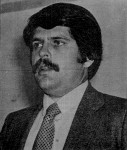Once he graduated from UCLA, Zev Yaroslavsky never really left West Los Angeles or the realm of politics.
Yaroslavsky, a former Los Angeles County supervisor and a UCLA alumnus, stepped down from office in December because of a term limit after nearly 40 years representing Westwood in local offices.
He first became involved in political activism as an undergraduate student at UCLA. In 1969, he formed the California Students for Soviet Jews, which was against the oppression of Jews in the Soviet Union at the time, and led multiple protests, including several at Meyerhoff Park.
“UCLA was a great environment, a politically active environment that really gave me an opportunity to hone my political skills,” Yaroslavsky said.
He was also instrumental in founding Ha’Am, UCLA’s Jewish student newsmagazine. He requested funding for the publication from the Associated Students UCLA Communications Board, according to Steven Halpern, a UCLA historian, in his book, “A View from Kerckhoff: A History of Student Life at UCLA.”
Even though the board defeated the initial proposal with a 5-5 vote in January 1972, Yaroslavsky tried again.
The board eventually approved the creation of the newsmagazine with a 5-3 vote.
Upon graduating UCLA in 1971, Yaroslavsky was ready to attend what is now known as the UCLA Anderson School of Management. But when he saw an opening in the L.A. City Council’s 5th District that included Westwood, he said he had a discussion with his wife and decided that if he were ever to make a political run, the time was then.
Yaroslavsky was behind in the primary in the City Council race, and his chief opponent, Frances Savitch had nearly all the endorsements from well-known politicians – including Mayor Tom Bradley and both U.S. senators from California.
“Zev was seen as this nobody. Most people thought he had no chance in hell of winning,” said Steven Sann, chair of the Westwood Community Council.
Yaroslavsky eventually won the race.
As a city councilmember, Yaroslavsky proposed a moratorium on housing around Westwood after residents criticized high-rise buildings for increasing traffic in the area.
Some constituents, however, said they think Yaroslavsky sometimes could have done more to stem the growth of the region.
Sandy Brown, president of the Holmby Westwood Property Owners Association, said she sometimes wished more could have been done to slow down the commercialization and development around the Wilshire-Westwood area.
Others, wanting to grow Westwood Village even further, have argued that the construction of high-rise buildings should have been continued because those buildings would allow for more students to live in Westwood and walk to campus.
“The traffic is there – don’t kid yourself,” said Paul Amir, president of Amir Development Company, which was completing large apartment complexes in the North Village, according to the Los Angeles Times in 1987. “UCLA causes the traffic problems.”
Starting in 1994, Yaroslavsky served on the L.A. County Board of Supervisors for 20 years, the maximum time allowed with term limits in place.
Yaroslavsky stayed close to his connections at UCLA, working with them to help accomplish his goals for the area. Many of his closest friends worked for the University, including former Chancellor Charles E. Young.
“He and I were both regularly on the sidelines at football games, and there’s a group of us – including Zev – that get together for dinner. We have had a very close relationship over the years,” Young said.
The two headed several neighborhood plans, including the Westwood Village Specific Plan and UCLA’s Long Range Development Plan.
Ginny Kruger, who worked under Yaroslavsky for 34 years, said she thinks Yaroslavsky was key in working to preserve what she calls Westwood Village’s historic charm by restricting building heights and protecting historic monuments.
“If it hadn’t been for Zev, Westwood wouldn’t be the village it is today. It wouldn’t feel like a village,” Kruger said.
